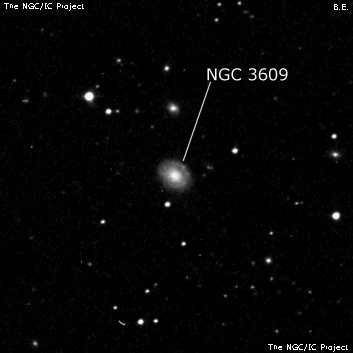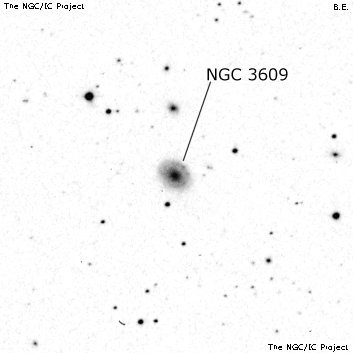NGC/IC Project Restoration Effort
(This is a very very beta version)
NGC3609


Basic Information
Location and Magnitude
Right Ascension: 11:17:50.6
Declination: +26:37:31
Constellation: LEO
Visual Magnitude: 13.3
Historic Information
Discoverer: Struve O.
Year of discovery: 1869
Discovery aperture: 15.0
Observational
Summary description: pF, S, bM
Sub-type: Sab
Corwin's Notes
=====
NGC 3609 is also NGC 3612. Steve Gottlieb noticed that Otto Struve found this
galaxy twice while searching for Comet Winnecke in the spring of 1869 at St.
Petersburg. Struve's first observation came on 16 March 1869 and clearly
refers to NGC 3609 -- but is listed in the NGC as "3612". The second
observation comes from 18 March 1869 and describes the same galaxy. The
positions are slightly different which misled both Struve and Dreyer into
thinking that Struve had seen two galaxies here, while he had in fact seen
only one.
Here are Struve's observations:
March 16 [1869]. alpha = 11h 10m 47s, delta = 27d 20m. Faint nebula about
30"-40" in diameter. Approximately 2 arcminutes north-following is a star
(10. 11), from which the nebula is in position angle 225d.
March 18 [1869]. alpha = 11h 10m 36s, delta = 27d 21m. Significantly
brighter than the previous one [NGC 3534], 20" in diameter, with evident
concentration towards the middle. Position angle from a 10th magnitude star
= 226d.
There are indeed two galaxies here, one about 25 seconds of time east of the
first. However, that second galaxy is fainter, has a lower surface
brightness, and -- in particular -- does not have the 10th-11th magnitude star
two arcminutes to the northeast.
Steve has also noticed that Struve's position for NGC 3534, mentioned in the
second observation on the same night, is offset from the true position by -13
seconds of time, close to the -15 seconds that Struve's position for NGC 3612
is offset from the true position. (The other galaxy from the same night, NGC
3563, has a position offset of only 4 seconds, but in the same direction.)
All of this makes it clear that Struve discovered the same galaxy twice. The
preferred number, by the way, is NGC 3609.
Steve's Notes
=====
NGC 3609
17.5" (4/22/95): faint, moderately large, round, 1.2' diameter. Weak concentration to a slightly brighter core. A mag 14 star is just off the south edge 50" from center and a second mag 14 star is 1.8' NW. A brighter mag 11 star lies 3.3' NE. Forms a pair with UGC 6321 (misidentified as NGC 3612 in modern sources) 5.4' E. UGC 6321 appeared extremely faint, small, round, 20" diameter, low surface brightness. A mag 11 star lies 3.9' NW.



